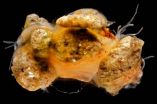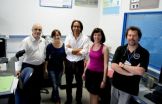(Press-News.org) Researchers from the University of Cadiz have made an unprecedented discovery: they have shown that there are five large accumulations of plastic debris in the open oceans, coinciding with the five main ocean gyres in the surface waters of the ocean. As well as the well-known accumulation of plastic rubbish in the North Pacific, these experts have proven the existence of similar accumulations in the centre of the North Atlantic, the South Pacific, the South Atlantic and the Indian Oceans. And they have gone one step further to state that the surface water of the centre of the oceans might not be the final destination of the plastic debris as large quantities of microplastics are entering the marine food chain and the ocean floors.
This project, led by the University of Cadiz and linked to the International Campus of Excellence of the Sea, is the front cover of the magazine Proceedings of the National Academy of Sciences (PNAS), one of the most important scientific publications in the world.
According to this study, the total amount of plastics accumulated on the surface of the world's oceans is tens of thousands of tonnes. "These microplastics influence the behaviour and the food chain of all sea creatures. On one hand, the small plastic fragments often accumulate pollutants which, if they are ingested, can pass into the organisms during digestion. They can also cause gastrointestinal obstructions which is another common problem with this type of debris. On the other hand, the abundance of floating fragments of plastic allows many small organisms to navigate and colonize areas previously inaccessible to them. However, a large part of the impact caused by plastic pollution in the oceans is probably still unknown", explains the professor and researcher from the UCA Andrés Cózar.
When plastic objects are transported by the ocean currents, they break up into smaller and smaller fragments due to solar radiation. However, these small plastic fragments, (known as microplastics) can last for hundreds of years. Plastic debris found on the ocean's surface is mainly polythene and polypropylene; polymers used in products such as plastic bags, drink and food containers, packaging, home utensils and toys.
To reach these conclusions and obtain the first global estimation of the amount of floating plastic debris on the ocean's surface, the team of researchers, led by Andrés Cózar, has focused on an analysis of all the samples taken in open ocean waters during the Malaspina Expedition in 2010. Samples taken far away from the coast and from city centres, but in which, in spite of this, floating plastic debris was found. In fact, this plastic debris was found in "88% of the ocean surface waters sampled. The results show the scale of the problem of plastic debris pollution worldwide" states the researcher from the University of Cadiz.
With the aim of stemming this worldwide pollution problem, the University of Cadiz insists on the need to go one step further and "as well as carrying out selective removal of debris from the coasts and the oceans, we must also get to the root cause of the problem, that is to say, the way the plastics continue to reach the oceans on such a large scale". Therefore, "it is necessary for all plastic products to be designed in such a way that really allows them to be used in a sustainable way. I consider that investment in research into reducing, reusing and making the plastic from commercial products really recyclable is not only a necessary measure from an environmental point of view, but also a lucrative investment from a commercial point of view. The oceans are no longer big enough to hide all the plastic waste that we generate", declares Professor Andrés Cózar.
The Malaspina 2010 Expedition
The Circumnavigation Expedition Malaspina 2010 is a project directed by the Spanish National Research Council (CSIC) and coordinated by the researcher Carlos Duarte, which is made up of over 400 scientists from all over the world and started on the 15th December 2010 when the ocean research ship Hesperides set sail from the port of Cadiz. On board this ship, belonging to the Spanish Navy, and the ship Sarmiento de Gamboa, the researchers studied the impact of global change on the ocean's ecosystems and explored its biodiversity for nine months (seven on board the Hesperides and two on board the Sarmiento).
The scientists took around 200,000 samples of water, plankton, fish and atmospheric particles and gases from 313 points in the Indian, Pacific and Atlantic Oceans, at depths of up to 6,000 metres. The circumnavigation is being used to carry out a thorough diagnosis of the state of the world's oceans and to explore the mysteries of their depths.
INFORMATION:
Researchers from the UCA prove the existence of large accumulations of plastic in all of the oceans
2014-07-03
ELSE PRESS RELEASES FROM THIS DATE:
'Work environment' affects protein properties
2014-07-03
Under the tutelage of Junior Professor Dr Simon Ebbinghaus, researchers from Bochum have demonstrated that the water surrounding the dissolved substances inside the cell plays a crucial role with regard to protein stability, which has frequently been neglected in the past. The researchers have published the results of their study, gained by means of simple model systems and thermodynamic analyses, in the Journal of the American Chemical Society (JACS). The results have been obtained following a collaboration under the umbrella of the Excellence Cluster RESOLV. The researchers ...
Groovy giraffes…distinct bone structures keep these animals upright
2014-07-03
Researchers at the Royal Veterinary College have identified a highly specialised ligament structure that is thought to prevent giraffes' legs from collapsing under the immense weight of these animals.
"Giraffes are heavy animals (around 1000 kg), but have unusually skinny limb bones for an animal of this size" explained lead investigator Christ Basu, a PhD student in the Structure & Motion Lab. "This means their leg bones are under high levels of mechanical stress."
In giraffes, the equivalents to our metatarsal bone (in the foot) and metacarpal bone (in the hand) are ...
Surprisingly stable long-distance relationships
2014-07-03
Contrary to what was thought, sequences of DNA called enhancers – which control a gene's output – find their targets long before they are activated during embryonic development, scientists at the European Molecular Biology Laboratory (EMBL) in Heidelberg, Germany, have found. Their study, published online today in Nature, also reveals that, surprisingly, the degree of complexity of enhancers' interactions in the 'simple' fruit fly Drosophila is comparable to what is seen in vertebrates.
"As an embryo develops, there are huge changes in transcription, much of which drives ...
Neurodegenerative diseases: Glitch in garbage removal enhances risk
2014-07-03
An international team of researchers identified a pathogenic mechanism that is common to several neurodegenerative diseases. The findings suggest that it may be possible to slow the progression of dementia even after the onset of symptoms.
The relentless increase in the incidence of dementia in aging societies poses an enormous challenge to health-care systems. An international team of researchers led by Professor Christian Haass and Gernot Kleinberger at the LMU's Adolf-Butenandt-Institute and the German Center for Neurodegenerative Diseases (DZNE), has now elucidated ...
Archaeopteryx plumage: First show off, then take-off
2014-07-03
Paleontologists of Ludwig-Maximilians-Universitaet (LMU) in Munich are currently studying a new specimen of Archaeopteryx, which reveals previously unknown features of the plumage. The initial findings shed light on the original function of feathers and their recruitment for flight.
A century and a half after its discovery and a mere 150 million years or so since it took to the air, Archaeopteryx still has surprises in store: The eleventh specimen of the iconic "basal bird" so far discovered turns out to have the best preserved plumage of all, permitting detailed comparisons ...
Cochrane Review on primaquine to prevent malaria transmission
2014-07-03
Researchers from the Cochrane Infectious Diseases Group, hosted at LSTM, conducted an independent review of the effects of adding a single dose of primaquine (PQ) to malaria treatment to prevent the transmission of the disease.
Mosquitoes become infected with Plasmodium falciparum when they ingest gametocyte-stage parasites from an infected person's blood. PQ is an antimalarial drug that does not cure malaria illness, but is known to kill the gametocyte stage of the P falciparum parasite, thus potentially limiting transmission to further humans. PQ is known to have potentially ...
More left-handed men are born during the winter
2014-07-03
Various manual tasks in everyday life require the use of the right hand or are optimized for right-handers. Around 90 percent of the general population is right-handed, only about 10 percent is left-handed. The study of Ulrich Tran, Stefan Stieger, and Martin Voracek comprised two large and independent samples of nearly 13000 adults from Austria and Germany. As in modern genetic studies, where a discovery-and-replication-sample design is standard, the use of two samples allowed testing the replicability and robustness of findings within one-and-the-same study. Overall, ...
Power consumption of robot joints could be 40 perecnt less, according to a laboratory study
2014-07-03
Let us imagine, for a moment, the arm of a robot that lifts a cup of coffee to its "lips" over and over again. The joint of this robotic arm needs a certain flexibility plus an electric motor to drive the upward and downward movements. So orders have to be sent to the motor so that the joint can perform the corresponding movements. "The motors need to receive orders constantly. In fact, the motor has to know at all times what angle its axis has to be at. However, current digital controllers only issue orders at specific moments (in discrete time); they can be described ...
Purdue-designed tool helps guide brain cancer surgery
2014-07-03
WEST LAFAYETTE, Ind. — A tool to help brain surgeons test and more precisely remove cancerous tissue was successfully used during surgery, according to a Purdue University and Brigham and Women's Hospital study.
The Purdue-designed tool sprays a microscopic stream of charged solvent onto the tissue surface to gather information about its molecular makeup and produces a color-coded image that reveals the location, nature and concentration of tumor cells.
"In a matter of seconds this technique offers molecular information that can detect residual tumor that otherwise ...
New insights into the treatment of children and youth exposed to acts of terror
2014-07-03
In a cluster of articles released today in the peer reviewed European Journal of Psychotraumatology, researchers provide new insights into the treatment of children and youth exposed to acts of terror. The work is drawn from studies examining the mass shooting at Utoya, Norway in 2011, and two school shootings in Finland – Jokela in 2007 and Kauhajoki in 2008.
A lead researcher in the cluster is noted Norwegian child psychiatrist and terror expert Dr. Grete Dyb of the University of Oslo and the Norwegian Center for Violence and Traumatic Stress Studies.
"Terror ...


